Morayshire Brick and Tile Manufactory, Lochside, Elgin, Morayshire aka Lochside Tileworks.
Below – 01/01/1847 – Elgin Courant – William Priest to establish a drain tile manufactory Lochside, Morayshire.

26/01/1849 – Elgin Courier – The Edinburgh Morayshire Mechanics Society – The 10th anniversary of this excellent and flouring Institution was celebrated in the Royal Hotel, Waterloo Place, Edinburgh on Friday 12th instant … 50 friends of the society sat down for supper … Mr Stephen thereafter rose and said – with all deference to my respected friend (Note – SBH – I am not sure who this was – the previous speaker was the Croupier but I cannot ascertain his name from the article) who has just sat down I beg to give a toast and in giving it, I am sure my friend will excuse me for assuming to encroach in some slight degree on the subject of his toast … in other words that draining is the most effective remedy for a refractory soil. In these circumstances then, we bestow all honour on the man who has put it into the power of our Morayshire agriculturalists to obtain at the very doors cheap and effective materials for carrying on the work of bettering the soil. (Great cheering) Till the establishment of the Morayshire Brick and Tile Works, our farmers were obliged to resort for such materials to Banff, Inverness or still more remote localities. We trust then that success and encouragement will crown his reputed enterprise and that he may revive in its pristine vigour, the true alchemic art of transmuting brick into gold. “The Morayshire Brick and Tile Manufactory” was drunk with cheers and (a voice), one cheer more for Mr Stephen, a real Morayshire “brick” – (laughter).
03/01/1851 – Elgin Courant – Notice – Contractors are wanted for digging about 1000 cubic yards of clay at the Morayshire Tileworks. Specifications will be shown and offers received by William Priest at the work on Tuesday 7th January 1851 at 12 o’clock noon. Lochside 27/12/1850.
Below – 17/10/1851 – Elgin Courier – Morayshire Tileworks.

.

23/04/1852 – Elgin Courant and Morayshire Advertiser – During the night of Sunday last, a fire broke out in the pottery department of the Morayshire Brick and Tile Manufactory, Lochside belonging to Messrs William Priest & Co and not being observed by any person in the neighbourhood the flames were allowed free scope and were not extinguished until the wooden shed in which it originated was completely consumed. Indeed it was not known such an accident had taken place till the workmen went to the manufactory on Monday morning. The value of the premises burned down is comparatively trifling but a considerable quantity of materials has been destroyed, among which was a portion of the 12-inch pipes preparing for the sewerage of the streets of this town. The damage is supposed to amount to about £150. The works and materials are partially insured in the Morayshire Insurance Company.
Below – 23/04/1852 – Elgin Courier – Fire at Morayshire Tileworks.

30/04/1852 – Elgin Courant – Morayshire Tilework – Regarding the partial destruction of these works by fire, as stated in our last, we learn that the manager and directors of the Morayshire Insurance Company, in whose office the Works were insured, have in the most prompt and honourable manner, paid the full value of the policy on the part destroyed. We understand that the pottery and water pipe department is still carried on in temporary erections and that in a few weeks the whole will be completed and in full operations. By distinctly specifying in the schedule the property insured, much trouble and inconvenience might be avoided by those having the misfortune to require the aid of Insurance Companies; and this having been attended to by the Lochside company accounts for the speedy settlement to their claim.
30/12/1853 – Elgin Courier – Improvement in drain tiles – Our readers engaged in draining are aware that hitherto it has been the practice, in effecting the junction between the furrow and the leader drain to make an opening in the side of the latter for the reception of the former. This arrangement has not been without its evils. It has been found that whenever the leader drain happens, as it often is, to be half-filled with water, the discharge of the water from the furrow is impeded, and silt, in consequence, collects at the junction. To remedy this, L.H.Spooner Esq, Assistant Drainage Commissioner, presently engaged in Banffshire has invented a connecting joint upon a new plan. Mr Spooner instead of making the furrow drain pass into the side of the leader brings it over the top – the junction being effected by a perforated brick of an ingenious construction. The brick is divided into 2 parts, the lower fitting like a saddle to the leader pipe and the upper resting upon and enclosing the end of the furrow pipe. The reader will easily see, that by this arrangement, the water flowing through the furrow falls into the leader pipe forming, indeed, a kind of cascade on a small scale, thus dispensing any sediment that may be in the pipe. Another indirect advantage resulting from this improvement is that while from absorption of moisture, the furrow pipes expand, and from their present position generally displace the leader pipe at the junctions, the absorption will now be prevented from operating in this way, the weight of the brick placed on the extremity rendering it next to impossible that the extension of the furrow can affect the leader pipe. We understand that these improved connection joints may be seen at the Morayshire Tilework, where, with Mr Spooner’s permission, they are now manufactured.
12/01/1854 – Inverness Courier – Improved draining tiles. To the Editor – Sir, In reference to a short paragraph in your last publication regarding the improvement that L. Spooner Esq, has made on the manner of joining the minor tile drains into the sub-main or main tile pipes; Mr Spooner has shown me a model of this. The minor tiles are inserted into the top of the main on a bush with a cap. It makes a neat effectual junction. It is the best I have seen and have no doubt it will be permanent. Yours respectfully John Sime.
24/02/1854 – Elgin Courier – Dinner and presentation to Robert Walker Esq, Leuchars. Provost Grant, in highly complimentary terms, proposed “prosperity to the Morayshire Tileworks with the name Mr Priest, Lochside” (all the honours). Mr Priest returned thanks. He said the Morayshire Tilework was but of small dimensions but nevertheless it had been the means of helping forward the agricultural improvements of this county. Not only had they supplied a large quantity of drain tiles to the several districts of Morayshire but they had manufactured for Banff, Caithness, Ross and Sutherlandshires. He thought it right to state, that but for the public spirit of the Earl of Seafield, in giving the use of the clay ground on reasonable terms, it was probable that there would not have been a tile work in this locality up to this day. (cheers).
Below – 25/07/1856 – Elgin Courant – Boy drowns at Morayshire Brick and Tile Works.

16/10/1857 – Elgin Courant – There is for sale, by private bargain, at the Morayshire Tile Works, a pair of good farm horses, 7 and 9 years old respectively. They will be sold worth the money as they are not longer required this season. Lochside 09/10/1857.
25/03/1858 – Elgin Courier – Contractors wanted – Contractors are wanted for erecting a tile kiln at the Morayshire Brick Tile and Pottery Works, according to specifications to be seen with Mr Priest, Lochside. Also for filling about 5000 cubic yards of clay pits with sand. The pits and bank of sand are so situated that a waggon rail might be employed with advantage. Offers will be received by Mr Priest at the works for both contracts on Wednesday the 7th April ensuing, at 12 0’clock noon on which day the work will be contracted for if suitable offers are given. Lochside 25/03/1858.
Below – 13/08/1858 – Elgin Courier – The Morayshire Brick and Tile Work – Story of the works. When a few years ago, the late Mr Priest originated a tile and brickwork at Lochside, some wise men shook their heads, gravely questioning whether such a manufactory could find employment here. After a time, however, the demand for tiles and other wares was greater than the work could supply; and the means of manufacture were considerably enlarged. Year after year additions were made to the works; and lately, it was found necessary to substitute steam power for men and horses, wherever it could be applied. A few weeks ago a first-class steam engine was put up at the works, the chimney stalk of which forms a conspicuous object in the “Laigh of Moray.” In connection with the engine, a clay mill has been erected on an improved model, which one end prepares clay for bricks, and at the other clay for tiles, milling it most efficiently, and in quantities sufficient for work double the size. The clay at this work has to be dug at a lower level than the bed of Loch Spynie, and the troughs left by the removal of the clay are thus speedily filled up with water. In this respect, the water had all along been an annoyance and hindrance to the work. A windmill was first tried, but it proved inefficient. Now, two powerful pumps are attached to the steam engine, capable of keeping the works clear of water, and of preventing any loss of time on this account. In fact, the steam power is applied wherever it can be done with advantage; and there is every probability of the Morayshire Tile Company being able ere long to meet all the demands upon them—increasing though these by every week. We notice the extension and enlargement of these works, as one of the many gratifying proofs which exist around us, of the public spirit and enterprise of Morayshire men. The tile manufacture will, we trust, prove remunerative to the spirited Company; and certainly has done, and is still doing much good for the county —both stimulating to increased drainage of lands, and distributing labour in the locality, money which would otherwise have gone a distant part the country.
Below – 24/09/1858 – Elgin Courier – Morayshire Brick and Tile Works secure a first-class potter and hands from the south. W. Priest & Co, Lochside, New-Spynie, Elgin.

04/03/1859 – Elgin Courier – Garden wares – Morayshire Brick and Tile Works – The subscribers beg to intimate that they are now prepared to supply all kinds of garden wares viz:- flower pots – size from 1 to 20 inches with flats to suit, seed pans, round and square of all sizes; Hyacinth, hedgehog, fern, round crocus, hollow bottomed and propagating pots (now so much used in gardening operations in the South); Sea-Kail (kale) and Rhubarb covers etc – W. Priest & Co, Lochside, New Spynie by Elgin, 24/02/1859.
05/12/1861 – Inverness Courier – International Exhibition of 1862 – The Elgin Courant states that eighteen feet of space has been allotted to Morayshire in the Exhibition of 1862. Mr Johnston, Newmill manufactory, has applied for fifteen feet of space to exhibit jerseys, tweeds, and other cloths of his own manufacture. Mr Robertson, druggist, Elgin, is to exhibit pharmaceutical productions, and probably medical preparations from the minerals of the district. Mr Priest, Lochside Pottery and Tileworks, has applied for space to exhibit tiles, &c. The Morayshire Farmer Club made an application for space on behalf of any of their members who may desire to send their productions.
Below – 06/12/1861 – Elgin Courier – Morayshire Brick and Tile Works background story.
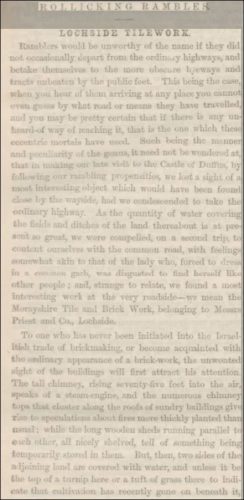
.
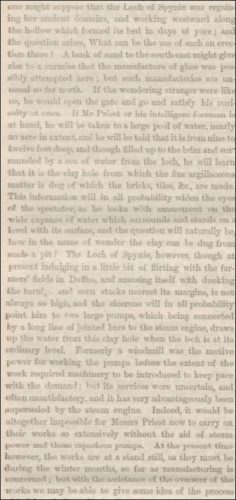
.
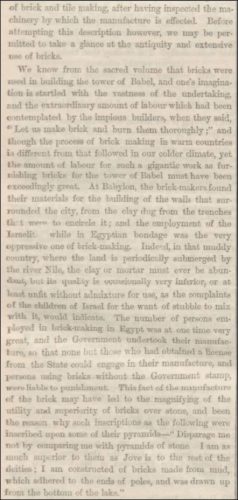
.

.

.

.

.

1862 – William Priest and Co, Lochside Tileworks, Elgin.
02/01/1862 – Inverness Courier – At Lochside, New Spynie on the 22nd, Robert, son of the late Mr William Priest, Morayshire Tileworks, aged 20 years.
Below – 1863 – Advert for the Morayshire Brick, Tile and Pottery Works, Lochside, Elgin.Wm M Priest and Co.

30/01/1863 – Elgin Courier – To contractors – offers are wanted for filling clay pits at the Morayshire Brick and Tile Works. Probable quantity from 5000 to 6000 cubic yards. Employers will find rail, waggons and sleepers etc. Further particulars may be learned and specifications seen by applying to Mr Pries or the foreman at the works up to Tuesday the 3rd February, on which day offers will be received at 1 o’clock pm. Lochside 28/01/1863.
13/03/1863 – Elgin Courier – Prince of Wales marriage – Elgin – Procession – brickmakers – after the printers came the brick makers from Mr Priests Lochside Tileworks, who made a gallant appearance, being headed by 2 pipers dressed in Royal Stewart tartan, who lustily blew their chanters all day long. They were about 43 of them. They carried a large flag with various devices of the trade and in the centre in the form of a circle ” Morayshire Brick and Tile Works”
23/10/1863 – Elgin Courier – Death – At 91 High Street, Elgin on 21st inst, Alexander Ross. labourer at Morayshire Tileworks, aged 35 years.
31/01/1865 – Banffshire Journal – Death – At 56 High Street, Bishopmill on 23rd inst, Ann Bower, wife of Mr P Campbell, Morayshire Tileworks, aged 33 years.
16/01/1866 – Aberdeen Peoples Journal – The Morayshire Brick and Tile Works were sold by public auction on the 8th inst when Mr William Grant, accountant, became the purchaser for a client at £4305, almost $400 above the upset price. It is understood the business will be carried on without change.
Below – 23/03/1866 – Elgin Courier – Death – Wm M. Priest.
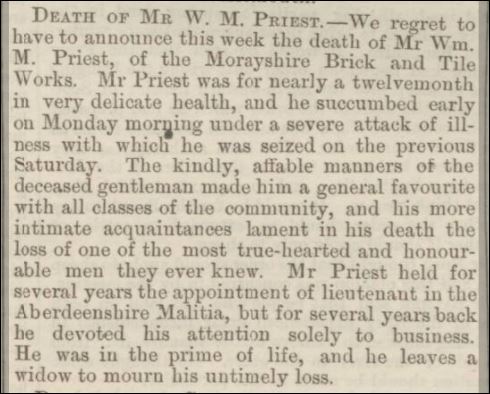
27/03/1866 – Banffshire and General Advertiser – Death – At Park Place, Elgin on the 20th inst, Wm M Priest Esq of the Morayshire Brick and Tile Works, aged 29 years.
1867 – William Priest and Co, brick and tile manufacturers, 141 High Street, Elgin.
10/07/1867 – Nairnshire Telegraph – Marriages – At Invererne House, Forres on 4th inst by the Rev A Robertson, Free Church, Mr James Christie, Manager, Morayshire Tileworks to Jane daughter of the late Mr Morrison, Grieve, Haughland.
27/12/1867 – Elgin Courier – At Lochside, Elgin on 18th, John Simpson, Post Runner, son of Mr James Simpson, Morayshire Tile Works, aged 25 years.
Below – 1868 – 1870 – Morayshire Brick and Tile Works.
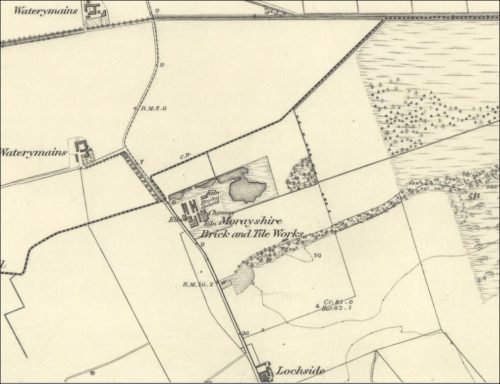
20/04/1869 – Banffshire and General Advertiser – Birth – At 125 High Street, Elgin on the 11th inst, the wife of Mr John Davidson, Morayshire Brick and Tile Works, of a son.
Below – 1870 – Morayshire Brick and Tile Works.

13/01/1870 – Inverness Courier – Deaths – At 12 High Street, Elgin on 14th inst, Mary Dallas, wife of Mr John Davidson, Morayshire Tileworks, aged 39.
29/01/1876 – Saturday Inverness Advertiser – Wanted for the Morayshire Tileworks, a brickmaker, a burner, a roofing tile moulder, a kiln setter and contractors for digging clay. None but steady and good workmen need apply. Wm Priest & Co, 8 North Street, Elgin.
02/01/1877 – Laird Brodie was entertained on Thursday last at a public dinner at Nairn. The dinner was given by the tenantry of Mr Brodie including William Christie, Morayshire Tileworks.
21/03/1877 – Aberdeen Press and Journal – Mr MacBey, Land surveyor, Darliston, Elgin. The deceased was for upwards of 20 years a partner in the firm of Wm Priest & Co, Morayshire Tileworks with which enterprise he continued his connection until his death.
03/03/1882 – Aberdeen Press and Journal – The Coast Railway Scheme meeting at Elgin. Reference to others and James Christie, Morayshire Brick and Tile Works possibly being required to attend a Parliamentary committee on the subject.
Below – 16/12/1885 – Aberdeen Press and Journal – Brick and Tile Works for sale, currently belonging to the firm of William Priest & Co.
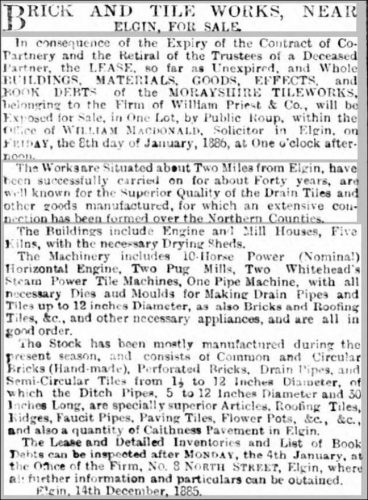
1886 – William Priest and Co, Morayshire Tileworks, Nr Elgin. Office 8 North Street.
Below – 02/01/1886 – The Scotsman – Morayshire Tileworks for sale.

14/01/1886 – Banffshire Advertiser – Sale of Morayshire Tileworks. On Friday the Morayshire Brick and Tile Works were put up to public roup in the office of Mr Macdonald, solicitor, at the upset price of £3910. After a keen competition, the works were sold to Mr Wm. Grant, accountant, for a client, at £4303. The business will be carried on as usual.
20/02/1886 – Aberdeen Press and Journal – Morayshire Farmers Society – Aberdeen Press and Journal – Morayshire Farmers Society – refers to Messers James Christie, Morayshire Tileworks attending the annual dinner.
30/04/1890 – Aberdeen Peoples Journal – The Great North of Scotland Railway Bill – The Elgin to Inverness Bill rejected … The Hopeman and Burghead Railway line proposal … The landowners and everyone along the route were enthusiastically desirous that the Great North should entertain the proposal. Starting from Elgin junction of the Lossiemouth tranch of the Great North system, it passes through the agricultural district near the town of Bishopmill and will serve also the Morayshire brick and tile works which are fairly extensive and provide considerable traffic.
02/05/1890 – Peterhead Sentinel – The Burghead Scheme rejected – The select committee continued on Wednesday consideration of that part of this bill which proposes to construct a branch from Elgin to Hopeman and Burghead and which was opposed by amongst others, the Highland Railway Company … Mr James Christie (of Messers W. Priest and Co of Morayshire Brick and Tile Works near Elgin) gave evidence in favour.
19/12/1893 – Banffshire and General Advertiser – Death – At 64 North Street, Bishopmill, Elgin on the 9th inst, James Simpson, for 40 years manager at the Morayshire Tileworks.
1894 – Northern Scot – … Having acquired the brickwork business in 1893 Mr James Christie (previously the manager) changed the company name to James Christie and Son
Below – 05/02/1897 – Elgin Courant – James Christie and Son, Morayshire Tileworks. Drainage pipes with or without collars.

10/12/1897 – Inverness Courier – James Christie & Son, Morayshire Brick and Tile Works – Office 8 North Street, Elgin. Have a large stock of drain pipes from 1¾” to 12″ in diameter. Semi-circle drain tiles (Muggs) from 2½” to 9″ also solid and perforated bricks 4½” and 6″ broad. Roofing and ridge tiles. Orders will have prompt attention.
25/03/1898 – Elgin Courant – James Christie & Son, Morayshire Brick and Tile Works, Elgin beg to intimate that they expect their new works to be ready in the spring of 1898 but in the meantime have worked up a large stock of wares of all kinds at the present works from which orders will be executed. Solid and perforated bricks, drain pipes, muggs, roofing tiles &c of the best quality now ready for delivery. Orders punctually attended to.
20/05/1898 – Elgin Courant – The draining of Loch Spynie has made a remarkable change in the appearance of the Laigh of Moray. The retreating waters were followed first by rough pasture grass, and afterwards, when the recovered acres were dry enough, by the transforming plough. Fair seed fields flourish today where years ago still waters reflected the sun or rippled under the breeze. Agricultural energy has done much to bring under subjection the wide expanse delivered up by the old loch, and now commercial enterprise is finding fresh methods of utilising what might almost be called the new territory. Close by the line of the railway to Lossiemouth, and almost due mat of Ardivot, a number of buildings, surrounding a tall chimney have within the last year gradually been rising. These buildings are the new Morayshire Brick and Tile Works of Messrs James Christie & son, Elgin. For a long period their old works at Lochside, about two miles further west, were well known to all Moray men, and to many far outside the bounds of the county. Claypits, however, like gold mines and mines of all descriptions, are not exhaustless. They give up their treasure to the last ounce if it is wanted, but the last spadeful, the last ounce are sure to be thrown up in process of time. So it is that the old Lochside works are abandoned. The clay deposits within the property bounds were worked out, and accordingly, Messrs Christie have moved eastward to a region which promises to be rich in the raw material. It has also advantages of a very important kind for the successful carrying on of the industry.
Although much still remains to be done, the works are so far advanced that the manufacture of bricks is now proceeding. Brickmaking has a somewhat prosaic sound, but, like all manufacturing processes, it is not without interest. The dull lump of moist clay has to endure much tribulation before it becomes a brick fit for the hand of the builder. It is shredded, and riven, and torn asunder, and kneaded by huge revolving fingers of steel; it is passed between rollers and other callous contrivances, and, after a short rest in the open air and the sunshine, it has to pass through the fiery furnace. No wonder that its original grey tint is altered to the peculiar red, the brick red, so different from every other ruddy hue. The process of brick-making at the new Morayshire Brick and Tile Works is worth seeing; and perhaps a few notes on the buildings and machinery will be of interest. Beginning with what may be called the heart of the factory, the source of power, we enter the boiler-room, which is of ample size, sufficient for its main purpose, with room to spare for a workshop with a lathe and other tools. Adjoining is the engine room, wherein is a “Caledonian” 40 HP. engine by Shanks of Arbroath, a massive yet handsome machine. There is much heavy machinery to drive, and the necessity of having plenty of motive power becomes clearer afterwards when one has had an opportunity of judging the load. Power is conveyed by heavy gearing to a brick-making shed, where the clay mills and machines are placed, and this department is now lively. Everything here is done in a modern style. From the clay pit some distance away a double line of 2 ft 3 in. railway has been laid, rising at a convenient gradient to the level of the first floor, where the ” hopper ” of the pug-mill is placed. An endless wire rope runs from end to end of the railway, turning on a large horizontal pulley at each end, and these pulleys are kept continually in motion. Little waggons run on the railway. One truck runs down to the clay pit; it is quickly loaded and hauled up to the railway proper, and, by a simple but ingenious clutch at the side, it is fastened to the steel rope and quickly hauled along the “up” line. This contrivance, it may be mentioned, has been devised by Mr William Munro, millwright, Urquhart, who has erected all the machinery. When the waggon arrives at the summit of the incline, and is just about to enter the shed, the clutch is released by an automatic arrangement, the waggon running on and “tipping” its load into the hopper of the mill. It is then sent along the “down” line empty to be re-filled. Meantime another loaded waggon approaches and is dealt with in the same way. And so on they go; waggons coming “up” full, and returning “down” empty. In the pug mills the clay is worked up and is fed into the brick machine, from which it emerges as a grey, plastic mass, neatly trimmed, and smooth all over. When a certain length of clay has been delivered it is immediately cut by special mechanism into ten bricks. These are placed on trays, and transferred to a three-wheeled lorry of peculiar construction, and hauled by a pony to the drying ground, where the bricks are “dyked.” On the north side of the works, there is a large well-lit shed into which shafting is being conveyed for working machines for drain pipes, perforated bricks, &c. It is also intended to utilise the exhaust steam from the engine for drying purposes, there being ample space available in the shed. There is also another shed for drain pipe making and drying. A very important part of the works is the kiln, which is a most elaborate structure and is a source of some surprise to the outsider whose ideas of a brick kiln are probably primitive and hazy. It is massively built and is of the “Hoffmann” pattern. On entering one could almost imagine he stood in a tunnel. The shape of the kiln may be described roughly as a parallelogram with rounded corners, covering a space of 131 feet 6 inches in length, and 50 feet in breadth. The internal length is 230 feet 6 inches, the width 15 feet, and the height to the crown of the arch is 8 feet 6 inches. This is divided into 12 chambers, which can be separated, when necessary, by iron doors. The kiln has two storeys, and eventually it will have three. On the ground floor, so to speak, are the chambers where the bricks will be placed for firing; on the first floor, there are several objects which attract notice. First of all, there are numerous little iron lids which, when lifted, disclose channels going down to the depths below. These are intended to allow small coal to be run into the mass of bricks or tiles ready built up for firing. Then there are man-holes, and a sense of dampers for regulating and shifting the heat. The smoke and fumes are carried by a flue to the chimney, which is 90 feet high., Ultimately the third storey of the kiln will be a shed for making and drying tiles. To thoroughly understand the working of the kiln would require an apprenticeship, but the main objects of the elaborate arrangement of chambers and flues are to fire the bricks properly, and at the same time to utilise to the utmost, all the heat generated. Economy in working, in brickmaking as in everything else, is half the battle.
The works, as we have already said, lie alongside the Lossiemouth branch railway, and a siding has been constructed, with a loading bank, which will enable the manufacturers to send their product quickly and economically into the market. The advantages of being so near the railway are obvious. It should be mentioned, too, that even the wandering winds are harnessed, and made to pump water from the clay pit. A tall, slender erection of steel stands on the brink of the pit, and day after day the wayfarer on the Elgin and Lossiemouth Road sees the windmill birling in the breeze. Messrs Christie & Son have shown no little enterprise in planning and laying out the new works, which, when finished, will be equal to all requirements. Buildings and plant mean heavy outlay, but everything has been done to ensure profitable working, and it is to be hoped that abundant success will crown this latest development of an old industry.
11/03/1899 – Northern Scot – Wanted for Morayshire Tileworks, to enter on his duties immediately, a man to attend engine and do joiner and fitter work. Apply to James Christie and Son, 8 North Street, Elgin. 10/03/1899.
26/12/1899 – Elgin Courant – James Christie and Son, Morayshire Brick and Tile Works, Elgin have on hand at their old works (Lochside) a quantity of second-class drain pipes of various sizes which in order to clear the ground they will sell at one-third of the price of first class. Also, some 1½ and 1¾ inch pipes with or without collars, first class, which they will sell on the same terms as the second class.
06/07/1900 – Shepton Mallet Journal – Mutilated by a flywheel – William Smith, an engineer, was on Saturday night oiling the flywheel of a traction engine at Morayshire Tileworks, Elgin when his clothes were caught by the wheel and he was drawn round. One of his arms was torn out and the other frightfully mangled. Several of his ribs were broken and the unfortunate man died 5 minutes after the accident.
1901 – 1904 – Lochside Tileworks, Elgin. William Priest and Co.
30/08/1901 – Aberdeen Press and Journal – Fatal accident inquiries at Elgin and Banff – Inquiries were held yesterday at Elgin – before Sheriff Webster and a jury – with reference to the deaths of George Michie, engine driver, Waterloo Place, Inverness and George Hunter, Manager, Morayshire Brick and Tile Works … With regard to the death of George Hunter, the evidence was simply that on 9th August last, a mare, which was described as a rather vicious, kicked him on the breast and throat while he was unhooking a shaft from a bogey. Hunter died from the result of the accident on 14th August. The verdict was given in accordance with the evidence.
1903 – James Christie & Son – Morayshire Tileworks; office, 8 North Street, Elgin.
07/04/1903 – Inverness Courier – James Christie & Son, Morayshire Brick and Tile Works, Elgin. Have large stocks on hand of all sizes of drain pipes and muggs. Orders by rail are promptly executed.
Below – 1904 – Morayshire Brick and Tile Works. The premises have moved site. See the article dated 20/05/1898 above.
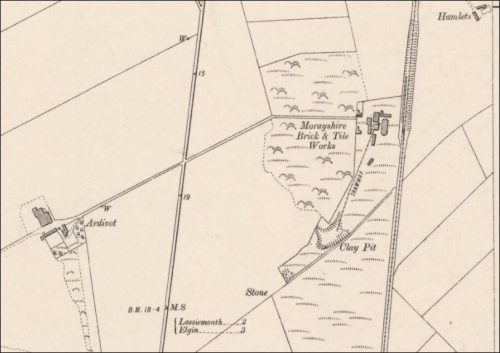
16/10/1915 – Northern Scot – Death of ex-provost James Christie, Elgin … a few years later we find him manager of the brick and tile works belonging to Messrs Willam Priest & Co about 2 miles from Elgin on the Gordonstoun Road. He was a partner in the firm from 1880 and finally acquired the business in 1893. The firm of William Priest & Co, which Mr Christie altered to James Christie & Son in 1894, had a very wide business connection all over the North and under Mr Christie it was greatly developed and extended. The works at Lochside were found to be inconvenient and a few years ago an excellent site was obtained between Spynie Palace and Lossiemouth with a siding on the great Northern Railway. Today the business is the largest of its kind in the North of Scotland and fire clay goods, cement and other building materials are distributed throughout a wide area. Mr Christie also carried on a business in coals and manure …
26/04/1932 – Brechin Advertiser – Deaths – At Morayshire Brickworks on 23rd April, Thomas Jolly, brickmaker, aged 73, late of Pugistone (Pugieston), Montrose.
31/12/1936 – Aberdeen Press and Journal – Years review of Morayshire industry – Tileworks – Business at Morayshire Tile Works was none too good. The industry is one however that depends to a larger extent on farming and with the improved prices which the farmer is now receiving, the assumption is that more money than has been the case for the past few years will be earmarked for drainage etc.
15/03/1938 – Edinburgh Gazette – The Firm of James Christie and Son, carrying on business as brick and tile manufacturers at the Morayshire Brick and Tile Works, near Elgin, and as coal merchants at 2 Commerce Street, Elgin, has been, by mutual consent, dissolved as at 1st March 1938, by the retiral therefrom of the subscriber James Alexander Christie, one of the partners.
The business will continue to be carried on by the remaining partner, Alexander Christie, on his own account and under the same name of James Christie and Son. The subscriber Alexander Christie is authorised to uplift all the debts due to, and he will discharge the whole liabilities of, the old firm. James A. Christie.
21/02/1939 – Aberdeen Press and Journal – refers to The Fletchers of Rosehaugh, The Black Isle reclaiming waste ground in 1864 – Loch Scadden drained – The land was first of all close drained. Thirty feet separated one lateral drain from the other. Deep drainage was then fashionable. No lateral was laid at a depth of less than 3 feet six inches. Tiles, obtained chiefly from the Morayshire Tile Works were used for laying the laterals. The leaders, for the most part, were built of stone.
23/02/1939 – Aberdeen Weekly Journal – Death at 63 North Street, Bishopmill, Elgin on 21/02/1939, James McNeil, aged 71 years, late of Morayshire Tileworks, beloved husband of Helen McDonald.
**************************
Below – 1863 – William Findlay, fire clay goods Merchant, Elgin. Some of the goods displayed may well be from the Morayshire Works.


























